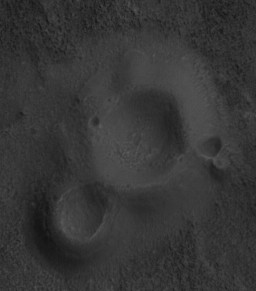
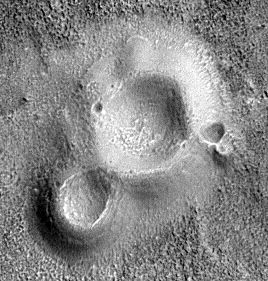
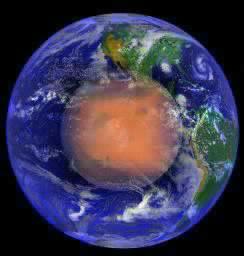
Cydonia Quest
C
Image Enhancements
C
The Rotunda
On Viking images the "Rotunda" appears to be a volcanic cinder cone on the plain South of the "Fort" and East of the East Formation in the "City". The reader may be able to make it out on this Viking context image µµµ. It is one of those smaller features in the Viking images that I was interested to see on the higher resolution MGS images. The Rotunda has actually been captured on two MGS images of which the highest resolution picture is M04-01903. This can be accessed in 40% and 100% versions on the MSSS Cydonia Page,µµµ. The clarity of the image on M04-01903 is better than on most of the other MGS images of Cydonia. However, the resolution is a low 4.7 metres (or just over 15 feet).


The crops on the left and right show how the Rotunda looks in the original published image and how it looks after the murky contrast is enhanced. At first glance the Rotunda still looks like a double cratered cinder cone. A closer look suggests that this is quite an artificial looking feature. The enlargement below helps us to see this more clearly. We can see three main "craters", which in order of descending size I will call "A", "B" and "C". The first thing that caught my eye about "A" was that it has polygon shaped lip. I can see the faint outline of a hexagon in this lip. Just as interesting is that the outer side of "A" also seems to consist of six facets. Looking inside "A" we can see evidence of some kind of structure. The shadowed part of the inside wall of "A" appears to have rows of rectangular indentations. The floor of "A" has a strange jumble of "beams" and "grids". If we adopt the artificiality hypothesis then "A" appears to be the ruin of a collapsed hexagonal shaped dome. The structures seen on its floor could be the exposed remains of a lattice work of beams that once supported the roof. The honeycomb of indentations that can be seen on some parts of the inner and outer walls of "A" could be internal support structures revealed by erosion.
Crater "B" is less interesting, but its appearance is consistent with a massive dome that has sagged in on itself. There is an interesting line of "caves" running horizontally along part of its outer wall. These could be tears in the "fabric" of the hypothetical dome caused by the stresses of its collapse.
"C" is difficult to explain as a volcanic feature. It is attached like a turret to the right hand side of "A" in the picture. It has unusually thin and steep walls and has a disproportionately deep "crater". It looks like a ruined architectural feature. Even more bizarrely, "C" has an even smaller and steeper turret like feature attached to it.
The reader may notice that the plain on the top, left hand side of these pictures is occupied by a jumble of walled enclosures. There is a rather a lot of this kind of feature in M04-01903 which will be enhanced in another image analysis. In order to have images that will download quickly and not eat up web space I've uploaded these images as JPEG files which compresses out fine detail. If the reader has their own image enhancing software I suggest that they try enhancing the Rotunda for themselves to get a better effect.
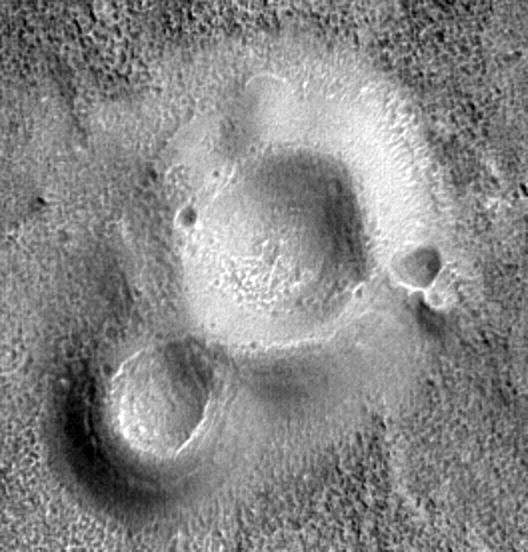
C
C
C
C
C
C
C
C
C
C
C
C
C
C
C
C
C
C
 The Doughnut
The Doughnut
I came across this little feature on MGS image M10-03053. This image is typical of most MGS images of Cydonia in that it was taken when the sky overhead was very hazy. The image enhancement of it is therefore rather limited in what it can do. I think the donut looks rather like a dome that has "deflated". Notice how the outside edge nearest to us (from a perspective point of view) seems to curl under itself. Also notice in the bottom left hand side how ribbing projects out from under this curl. The top and interior edge of the Donut ring have holes and tears that would be consistent with the downward slump of the middle parts of a dome roof. The resolution in this picture is 3.1 metres (around 10 feet) - but this means little with the scattering of light from a dusty atmosphere degrading the picture.
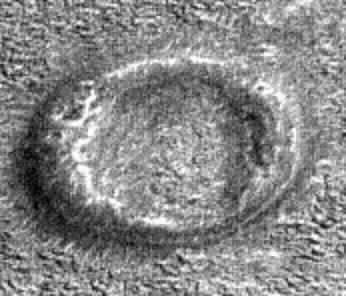
µ Next Page